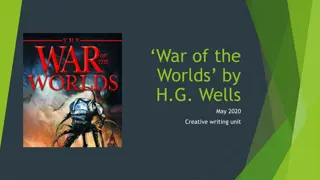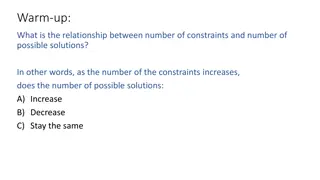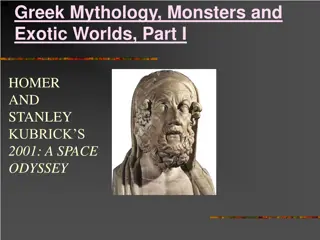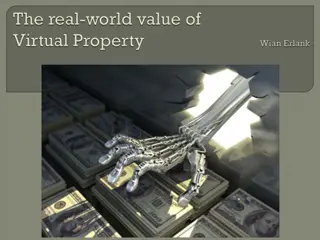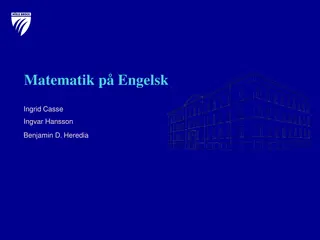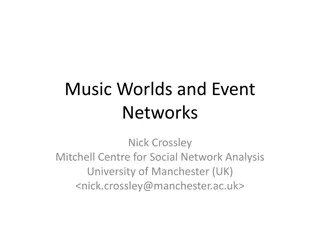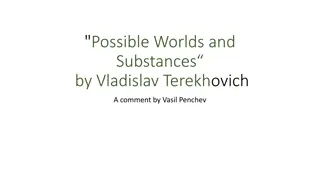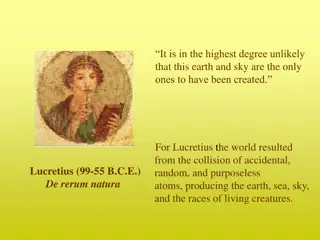
Understanding Lewis' Counterfactual Theory of Causation and Modal Realism
Explore David Lewis' Counterfactual Theory of Causation and Modal Realism in Day 4 of the course. Dive into topics like counterfactual conditionals, causal dependence, identity, and objections to modal realism. Discover the complexities of truth conditions for counterfactuals and the logic behind Lewis' theory.
Download Presentation

Please find below an Image/Link to download the presentation.
The content on the website is provided AS IS for your information and personal use only. It may not be sold, licensed, or shared on other websites without obtaining consent from the author. If you encounter any issues during the download, it is possible that the publisher has removed the file from their server.
You are allowed to download the files provided on this website for personal or commercial use, subject to the condition that they are used lawfully. All files are the property of their respective owners.
The content on the website is provided AS IS for your information and personal use only. It may not be sold, licensed, or shared on other websites without obtaining consent from the author.
E N D
Presentation Transcript
Possible Worlds Cathy Legg University of Waikato
Day 4 TOPICS Lewis Counterfactual Theory of Causation Counterfactual Conditionals Causal Dependence Testing the Counterexamples to Hume Identity Quantitative vs Qualitative Leibniz Law Modal Realism Objections to Modal Realism
Lewis Counterfactual Theory of Causation Identity Modal Realism Day 4 Counterfactual Conditionals A counterfactual conditional describes a situation which happens not to be true, but which is possible (in some sense of possible). E.g: i. If kangaroos had no tails then they would fall over. ii.If the US had not dropped the nuclear bomb on Japan, then World War Two would have lasted longer than 6 years. iii.If Mum had married Lionel, then I would never have been born (and so on) It is pretty clear that we have all kinds of knowledge about counterfactuals. Although we could have an interesting discussion about how we get that knowledge
Lewis Counterfactual Theory of Causation Identity Modal Realism Day 4 Logic Link: Counterfactual conditionals cannot be analysed in the simple way that if-then is analysed in introductory logic namely: (a.k.a. the material conditional) Challenging question in philosophical logic: Why not? What are the differences in truth-conditions? According to the truth-conditions for the material conditional, all counterfactual conditionals come out true. (Because X Y is only false when X is true and Y is false. Otherwise it is true.) But that is not the result we want. We want to be able to say, for instance: If I had entered the 2003 New York marathon then I would have been tired: TRUE If I had entered the 2003 New York marathon then I would have won: FALSE If Brad had not kissed Jennifer or Angelina then he would not have measles: TRUE If Brad had kissed Angelina but not Jennifer then he would not have measles: FALSE.
Lewis Counterfactual Theory of Causation Identity Modal Realism Day 4 David Lewis theory of the logic of counterfactuals: Lewis represents counterfactual conditionals by an entirely different symbol: Here are its truth-conditions: X Y is true iff: i) there are no possible worlds where X is true OR: ii) at all the closest possible worlds where X is true, Y is also true Questions: Why clause i)? Why clause ii)? (Note: This is not the only theory of the logic of counterfactuals. There are quite a few different theories, many more recent than Lewis (~1975), with no real consensus amongst philosophers at the present time, interestingly.)
Lewis Counterfactual Theory of Causation Identity Modal Realism Day 4 Back to metaphysics:What does closest mean here?? Here Lewis relies on a primitive , objective relation of similarity amongst possible worlds. Some things just are more similar to each other, in an overall sense. E.g. a rabbit is more similar to a hare than it is to a cockroach, objectively. Similarly, then, possible worlds where I run the New York Marathon with my current body are more similar to the actual world than worlds where I run the New York marathon with the body of Hamish Carter. And in worlds where I run the New York Marathon with my current body, I don t win. That is why the sentences below have the truth-values they do: If I had entered the 2003 New York marathon then I would have been tired: TRUE If I had entered the 2003 New York marathon then I would have won: FALSE
Lewis Counterfactual Theory of Causation Identity Modal Realism Day 4 How does all this help us get a Theory of Causation? Lewis proceeds in two stages: 1) First define causal dependence: y causally depends on x iff O(x) LEXICON: Ox: x occurs. O(y), and ~O(x) ~O(y) In other words: in the closest possible worlds where x occurs, y also occurs andin the closest possible worlds where x doesn t occur, y doesn t either. Question: Why does Lewis need both halves?
Lewis Counterfactual Theory of Causation Identity Modal Realism Day 4 2) Then define causation itself in terms of causal dependence: x causes y iff there is a chain of events leading from x to y, each stage of which causally depends on the previous stage. Another question: Why the second stage? Why the chain? Test case: The steak I left on the bench getting chewed was caused by my leaving the cat inside this morning. [see over for analysis ]
Lewis Counterfactual Theory of Causation Identity Modal Realism Day 4 CAUSES 1. Leave cat inside 5. Steak in bad shape CAUSALLY DEPENDS CAUSALLY DEPENDS 2. Cat sees steak 4. Cat chews steak 3. Cat decides to get steak
Lewis Counterfactual Theory of Causation Identity Modal Realism Day 4 Does this Theory Solve Lewis Original Objections to Hume? Exercise (groups of 3-4) For each of the sentences below: i) work out its truth conditions according to Lewis counterfactual theory of causation, ii) think about the relevant possible worlds, iii) discuss whether the truth-value given by Lewis theory to this sentence is correct. i) Pre-empted Potential Causes: Brad s kissing Angelina caused him to get measles. ii) Epiphenomena: Having measles spots caused me to have a high fever. iii) Effects: Having measles caused me to have contact with the measles virus.
Lewis Counterfactual Theory of Causation Identity Modal Realism Day 4 Introduction to Identity We will begin by looking at the concept of identity itself. And, as always, we will ask: What does this fundamental concept mean? A distinction is often made in philosophy between two kinds of identity: qualitativeidentity quantitative (sometimes also called numerical ) identity Two things are qualitatively identical if they share all their properties. If one is green, the other is green, if one is 2 feet long, the other is 2 feet long ..and so on. Two things are quantitatively identical if they are actually the same thing. I.e. there is only one thing there (hence quantitative identity).
Lewis Counterfactual Theory of Causation Identity Modal Realism Day 4 It is often thought possible to have qualitative identity without quantitative identity (How? What would be an example?) Hard metaphysical questions: i) If two things are qualitatively identical but not quantitatively identical, in virtue of what are they not HintHint quantitatively identical? ii) Can you have quantitative identity without qualitative identity? If so, what would be an example? Hint:
Lewis Counterfactual Theory of Causation Identity Modal Realism Day 4 Leibniz s Law This famous law (not really a law like a law of physics, but a claim in metaphysics) relates qualitative and quantitative identity. It has two halves: 1) The Indiscernibility of Identicals: If two things are identical (quantitatively) then they share all their properties. 2) The Identity of Indiscernibles: If two things share all their properties then they are identical (quantitatively). Logic Link, again requiring some logical sophistication:Express both laws in formal logic. What kind of a logic is required in order to do this?
Lewis Counterfactual Theory of Causation Identity Modal Realism Day 4 Qualitative and Quantitative Identity Summed Up: You can have qualitative identity without quantitative identity insofar as two things might share all their properties (even, in some sense, their spatiotemporal location in a symmetrical universe) and yet still be different in the sense that this is THIS thing and that is THAT thing (!) Metaphysicians sometimes express this idea by saying that the two things have different thisnesses. The traditional medieval Latin term for this is: haecceities - if that helps
Lewis Counterfactual Theory of Causation Identity Modal Realism Day 4 Qualitative and Quantitative Identity Summed Up: You can have quantitative identity without qualitative identity insofar as the passage of time allows a thing to change, and thus have different even contradictory properties at different times Some metaphysicians deny this by holding a view in which only time-slices of things (infinitely thin temporal parts) are strictly identical to one another, and a thing which is extended in time, such as a person, is only really a collection of time- slices which are actually different things. These philosophers are called perdurantists. Philosophers who deny this, and hold that there is quantitative identity across time, are called endurantists.
Lewis Counterfactual Theory of Causation Identity Modal Realism Day 4 Warm-up exercise: Watch this clip from the movie Sliding Doors. In this movie two possible scenarios are explored one where Helen catches the train and consequences follow, and another where she misses the train and consequences follow. We can all think of counterfactual cases like this in our own lives. (Dates you didn t go on, car accidents you avoided...and so on). What if anything determines that this is the situation that actually happened? We have already bravely confronted the brain-bending question: What makes now now? Along the same lines, we now ask: What makes the actual actual?
Lewis Counterfactual Theory of Causation Identity Modal Realism Day 4 Introduction to Modal Realism: David Lewis is somewhat notorious for defining a particular form of realism about possible worlds, which he calls modal realism, and claiming to believe it. We have now had a brief look at the logic of counterfactual conditionals. This is a reasonably well-worked out framework for determining the truth-values of these conditionals. Is there anything we can say about reality that might explain why counterfactual conditionals work this way? Lewis: yes there is: possible worlds are part of reality too! We thought that we only lived in one Universe, the so-called actual world. But this actual world is just one among many many (infinitely many) possible worlds, which differ from the actual world in all possible (!) ways.
Lewis Counterfactual Theory of Causation Identity Modal Realism Day 4 Lewis claims that for every proposition we wish to say is possible, there exists a possible world where that proposition is true. E.g. there are worlds just like this one, except that donkeys talk everyone has a piece of toast on their head human beings have wings John Lennon was never assassinated my mother married Lionel .and so on, for every possible distribution of properties imaginable
Lewis Counterfactual Theory of Causation Identity Modal Realism Day 4 Lewis makes the following claims about these other possible worlds: they exist just as concretely as the actual world (!) (Parity)* they are spatiotemporally disconnected from the actual world (Isolation)* There are as many possible worlds as there are possible ways things might be (Plenitude)* (*Brock and Mares, see FURTHER READING) How might one argue for Modal Realism? i) There is such an elegant symmetry with indexical accounts of space and time.
Lewis Counterfactual Theory of Causation Identity Modal Realism Day 4 i) There is such an elegant symmetry with indexical accounts of space and time. This time is now! http://tbn0.google.com/images?q=tbn:RZDE7Wy_zxcj1M:http://iamthewitness.com/books/img/King.Henry.VIII.jpg This time is now! http://tbn1.google.com/images?q=tbn:PSnFF5RHtsPbuM:http://upload.wikimedia.org/wikipedia/commons/thumb/9/94/Stick_Figure.svg/300px-Stick_Figure.svg.png This place is here! This place is here! 1536, ENGLAND TIME-LINE (this way to the future 2012, USA ) Nobody tries to argue that here is not indexical for instance by saying things like, The point in space where I am standing is really here! You can t say that where you are standing is here because here is right here! Arguably, such disputes would only show that you don t understand the meaning of here . (We ve seen that now is more contested, but arguably analogous.)
Lewis Counterfactual Theory of Causation Identity Modal Realism Day 4 Space-time Discontinuity Treating actual as indexical: This world is actual, and donkeys don t talk This world is actual http://tbn1.google.com/images?q=tbn:PSnFF5RHtsPbuM:http://upload.wikimedia.org/wikipedia/commons/thumb/9/94/Stick_Figure.svg/300px-Stick_Figure.svg.png http://tbn1.google.com/images?q=tbn:PSnFF5RHtsPbuM:http://upload.wikimedia.org/wikipedia/commons/thumb/9/94/Stick_Figure.svg/300px-Stick_Figure.svg.png http://tbn1.google.com/images?q=tbn:JlDVYuSIvAiqsM:http://newsimg.ngfiles.com/149000/149898_Donkey.jpg Hey bro! OUR POSSIBLE WORLD ANOTHER POSSIBLE WORLD It is sometimes said that the most simple, elegant theory is the most likely to be true (Ockham s Razor) Or is it?
Lewis Counterfactual Theory of Causation Identity Modal Realism Day 4 How might one argue for Modal Realism? LOGIC LINK: ii) Existential quantification Most of the other things we existentially quantify over exist. That is why it is called existentialquantification. E.g: There are some sausages in the freezer. Some people are very annoying. There were times in my life I was happier than now. All events have a cause. The propositions above quantify over sausages, people, times and causes. We believe that these things all exist. Now, we also say things like: There are many ways things could have been other than the way they are. This too is an existential quantification .So surely these ways things could have been also exist .?? Is this a good argument? Why or why not?
Lewis Counterfactual Theory of Causation Identity Modal Realism Day 4 (Your thoughts?) How might one argue against Modal Realism? The incredulous stare. Lewis says that this is the most common reaction he receives to his theory. Reply: It is hard to say much in reply to this, and maybe one doesn t need to Epistemological concerns. How can you say you know that these other worlds exist when they are spatiotemporally disconnected from the actual world and you really don t know what s in them? Lewis Reply: That I don t know what is in the worlds is just what you would expect, actually. That is what it is to be a realist about something if you think that x is real, then you think that it is independent of you, i.e. you didn t make it up so you don t know everything there is to know about it!
Lewis Counterfactual Theory of Causation Identity Modal Realism Day 4 Final exercise: (small groups) i) Do you think you might be willing to believe Lewis theory? Why or why not? ii) Lewis developed the theory as he wanted to be realist about possibilities. He thought there are objective truths about what is possible and what is not possible (in our 3 different senses of course). Is he right about this? And if so, is there any other way he might be able to have realism about possibility, without having to hold that other possible worlds exist?
Lewis Counterfactual Theory of Causation Identity Modal Realism Day 4 FURTHER READING: Philosophy: David Lewis, Causation , in Causation and Conditionals, ed. Sosa (Oxford: Oxford University Press, 1975), pp. 180-191. (fitelson.org/269/Lewis_Causation.pdf) David Lewis, Counterfactuals and Time s Arrow , No s13, pp. 455-76. Peter Menzies, Counterfactual Theories of Causation , Stanford Encyclopedia of Philosophy, http://plato.stanford.edu/entries/causation-counterfactual/ David Lewis, Possible Worlds , in Loux, ed., The Possible and the Actual (Ithaca: Cornell University Press, 1979), pp. 182-189. [Lewis also has a whole book devoted to his modal realism: On the Plurality of Worlds (Oxford, 1986). However this article conveniently summarises the most important points.] S. Brock and E. Mares, Realism and Anti-Realism (McGill-Queens, 2007) [chapter 11 discusses modal realism in detail]
Lewis Counterfactual Theory of Causation Identity Modal Realism Day 4 FURTHER READING, cont: Philosophy: William G. Lycan, Review of On the Plurality of Worlds by David Lewis , The Journal of Philosophy, Vol. 85, No. 1. (1988), pp. 42-47 [addresses the radical and apparently crazy nature of Lewis theory] Harold Noonan, Identity , Stanford Encyclopedia of Philosophy, http://plato.stanford.edu/entries/identity/ Fiction: Jorge-Luis Borges, The Library of Babel : http://jubal.westnet.com/hyperdiscordia/library_of_babel.html [another baffling, absurd, wondrous fable from Borges. To me it constructs an interesting reductio ad absurdam of the plenitude which constitutes Lewis modal realism. Also says a lot about our modern information -laden society. Have a look and see what you think.]

![❤[READ]❤ Cosmic Biology: How Life Could Evolve on Other Worlds (Springer Praxis](/thumb/21556/read-cosmic-biology-how-life-could-evolve-on-other-worlds-springer-praxis.jpg)


